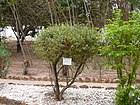Note: This is a project under development. The articles on this wiki are just being initiated and broadly incomplete. You can Help creating new pages.
Lawsonia inermis - Mendhika
Henna is a flowering plant and the sole species of the Lawsonia genus. It is a heavily-scented, much-branched, slender, evergreen shrub or small tree. It usually grows up to 6 metres tall. The stems and older branches can be spiny. Henna has been used for thousands of years, especially in India, as a cosmetic and hair dye. It is one of the oldest cosmetics in the world and its leaves are used to colour the fingernails, to paint or decorate the palms of the hands and the soles of the feet, and to dye the hair. This plant is belongs to Lythraceae family.[1]
Contents
- 1 Uses
- 2 Parts Used
- 3 Chemical Composition
- 4 Common names
- 5 Properties
- 6 Habit
- 7 Identification
- 8 List of Ayurvedic medicine in which the herb is used
- 9 Where to get the saplings
- 10 Mode of Propagation
- 11 How to plant/cultivate
- 12 Commonly seen growing in areas
- 13 Photo Gallery
- 14 References
- 15 External Links
Uses
Bleeding, Nerve deseases, Amoebic dysentery, Wounds, Skin eruptions, Ulcers, Pimples, Diarrhea, Sore throats.
Parts Used
Chemical Composition
The major components were ethyl hexadecanoate (24.4%), (E)-methyl cinnamate (11.4%), isocaryophyllene (8.1%), (E)-β-ionone (5.8%) and methyl linolenate (4.1%).[2]
Common names
| Language | Common name |
|---|---|
| Kannada | Goranta, Gorante |
| Hindi | Hena |
| Malayalam | Mail-anschi, Mailanci |
| Tamil | Aivanam, Aivanam |
| Telugu | Goranta, Gorata |
| Marathi | NA |
| Gujarathi | NA |
| Punjabi | NA |
| Kashmiri | NA |
| Sanskrit | Dvivranta, Kokadanta |
| English | Henna |
Properties
Reference: Dravya - Substance, Rasa - Taste, Guna - Qualities, Veerya - Potency, Vipaka - Post-digesion effect, Karma - Pharmacological activity, Prabhava - Therepeutics.
Dravya
Rasa
Guna
Veerya
Vipaka
Karma
Prabhava
Habit
Identification
Leaf
| Kind | Shape | Feature |
|---|---|---|
| Simple | Henna is a thorny evergreen shrub that can reach up to 6.0 m in heightThe leaves are divided into 3-6 toothed leaflets, with smaller leaflets in between |
Flower
| Type | Size | Color and composition | Stamen | More information |
|---|---|---|---|---|
| Unisexual | 2-4cm long | Yellow | 5-20 | The fragrant flowers are whitish or pink to brick red and sit in a pyramid-shaped inflorescence |
Fruit
| Type | Size | Mass | Appearance | Seeds | More information |
|---|---|---|---|---|---|
| Simple | 7–10 mm | The fruit is a blue-black berry | Single | {{{6}}} |
Other features
List of Ayurvedic medicine in which the herb is used
Where to get the saplings
Mode of Propagation
How to plant/cultivate
Seed - germinates best at temperatures around 25°c. Because of their hard seedcoats, the seeds have to be pre-germinated before sowing.[5]
Commonly seen growing in areas
Warmer parts of South and North America, Meadows, Borders of forests and fields.
Photo Gallery
References
- ↑ Karnataka Aushadhiya Sasyagalu By Dr.Maagadi R Gurudeva, Page no:127
- ↑ Chemical constituents
- ↑ Plant description
- ↑ Ayurvedic preparations
- ↑ Cultivation Details
External Links
- Ayurvedic Herbs known to be helpful to treat Bleeding
- Ayurvedic Herbs known to be helpful to treat Nerve deseases
- Ayurvedic Herbs known to be helpful to treat Amoebic dysentery
- Ayurvedic Herbs known to be helpful to treat Wounds
- Ayurvedic Herbs known to be helpful to treat Skin eruptions
- Ayurvedic Herbs known to be helpful to treat Ulcers
- Ayurvedic Herbs known to be helpful to treat Pimples
- Ayurvedic Herbs known to be helpful to treat Diarrhea
- Ayurvedic Herbs known to be helpful to treat Sore throats
- Herbs with Leaves used in medicine
- Herbs with Seeds used in medicine
- Herbs with common name in Kannada
- Herbs with common name in Hindi
- Herbs with common name in Malayalam
- Herbs with common name in Tamil
- Herbs with common name in Telugu
- Herbs with common name in Sanskrit
- Herbs with common name in English
- Habit - Evergreen shrub
- Index of Plants which can be propagated by Cuttings
- Index of Plants which can be propagated by Seeds
- Herbs that are commonly seen in the region of Warmer parts of South and North America
- Herbs that are commonly seen in the region of Meadows
- Herbs that are commonly seen in the region of Borders of forests and fields
- Herbs
- Ayurvedic herbs that don't have flower, fruit and leaf photos
- Ayurvedic herbs that don't have seed photos
- Lythraceae




